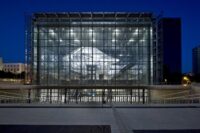- Home
- Articles
- Architectural Portfolio
- Architectral Presentation
- Inspirational Stories
- Architecture News
- Visualization
- BIM Industry
- Facade Design
- Parametric Design
- Career
- Landscape Architecture
- Construction
- Artificial Intelligence
- Sketching
- Design Softwares
- Diagrams
- Writing
- Architectural Tips
- Sustainability
- Courses
- Concept
- Technology
- History & Heritage
- Future of Architecture
- Guides & How-To
- Art & Culture
- Projects
- Interior Design
- Competitions
- Jobs
- Store
- Tools
- More
- Home
- Articles
- Architectural Portfolio
- Architectral Presentation
- Inspirational Stories
- Architecture News
- Visualization
- BIM Industry
- Facade Design
- Parametric Design
- Career
- Landscape Architecture
- Construction
- Artificial Intelligence
- Sketching
- Design Softwares
- Diagrams
- Writing
- Architectural Tips
- Sustainability
- Courses
- Concept
- Technology
- History & Heritage
- Future of Architecture
- Guides & How-To
- Art & Culture
- Projects
- Interior Design
- Competitions
- Jobs
- Store
- Tools
- More
The Importance of Living Space in Architectural Form: Enhancing Design and Everyday Life
Discover how living spaces transcend aesthetics in architecture, shaping emotions, behaviors, and daily life. Explore the role of thoughtful design, cultural influences, natural elements, and sustainability in creating adaptable, functional, and emotionally fulfilling environments.

When we think about architecture, we often focus on aesthetics or structural integrity, but the true essence lies in how spaces shape the way we live. Living spaces aren’t just physical areas; they’re environments that influence our emotions, behaviors, and daily routines. The connection between architectural form and the functionality of these spaces is what transforms a house into a home.
Our living spaces should reflect who we are while meeting our needs for comfort and efficiency. Thoughtful design considers natural light, flow, and adaptability, ensuring every square foot serves a purpose. It’s not just about fitting furniture—it’s about creating harmony between the space and its occupants.
By prioritizing living spaces in architectural design, we create environments that enhance well-being and foster connection. After all, architecture isn’t just about buildings; it’s about the lives lived within them. Let’s explore why these spaces matter so much.
Table of Contents
ToggleUnderstanding Living Space In Architecture

Living space in architecture refers to areas where daily life unfolds. These spaces encompass essential functions like sleeping, cooking, and relaxation, emphasizing the balance between practicality and emotional well-being. When we design living spaces, we consider factors such as size, layout, and adaptability to meet diverse needs.
Spatial flow plays a crucial role in creating functional living environments. Homes with poor layouts can limit movement and create disorganization, while well-thought-out plans allow effortless transitions between rooms. For example, open-concept designs often promote interaction and flexibility, which are key for modern lifestyles.
Natural elements significantly impact the quality of living spaces. Maximizing natural light and ventilation improves air quality and increases a space’s usability throughout the day. Incorporating these features supports healthier living and aids energy efficiency, reducing reliance on artificial lighting and cooling.
We also examine cultural and social dynamics when shaping living spaces. Designs often reflect societal norms and family structures, creating environments that accommodate shared activities or personal retreats. For instance, a multi-generational home may include additional private zones while keeping shared areas accessible.
Through intentional design, living spaces fulfill both tangible and intangible needs, reinforcing architecture’s role in enhancing daily experiences.
The Role Of Living Space In Architectural Form
Living spaces serve as the foundation of architectural design, shaping how occupants interact with their environment. They address functional, emotional, and cultural needs, linking human experiences to structural forms.

Historical Perspectives On Living Space
Historically, the concept of living space has evolved alongside society’s changing priorities and technological advancements. Ancient Greek and Roman architecture integrated form and function, creating shared spaces like courtyards that blended communal and private areas. Medieval designs emphasized defensive utility, often sacrificing spaciousness for security, while Renaissance homes reintroduced symmetry and proportion, prioritizing aesthetic harmony.
In traditional Japanese architecture, living spaces showcased flexibility and simplicity through sliding walls and tatami flooring, demonstrating adaptability. Similarly, indigenous designs globally reflect environmental adaptations, using local materials and layouts suited to climatic conditions. Across cultures, these examples reveal how living spaces have always mirrored societal values and environmental constraints.
Modern Interpretations And Innovations
Today, modern living spaces embrace open-plan designs, sustainability, and smart technologies. Open-concept layouts reduce barriers, fostering connectivity and maximizing space utility. Innovations in energy-efficient materials, such as insulated glass and sustainable concrete, enhance both comfort and environmental responsibility.
Smart home technologies integrate seamlessly into living spaces, offering features like automated lighting, climate control, and security systems. Modular and multi-functional furniture designs optimize limited room sizes, catering to urban density. Moreover, biophilic design integrates natural elements like indoor greenery, enhancing psychological well-being and air quality. Modern architecture prioritizes adaptability, supporting diverse lifestyles and future needs.
Key Elements Of Effective Living Space Design
Effective living space design combines purpose and experience, addressing practical needs and emotional fulfillment. By prioritizing functionality, comfort, and sustainability, we create environments that enhance daily life.

Functionality And Flow
Functionality ensures that spaces meet the practical demands of daily life. Efficient layouts optimize movement between areas and reduce wasted space. For example, open-plan designs enhance connectivity between kitchens and living rooms, allowing seamless activity transitions. Proper zoning separates private and communal spaces, improving organization. Flow, or how users navigate a space, relies on logical pathways and intuitive design, such as positioning entrances and exits to minimize obstacles.
Comfort And Aesthetics
Comfort balances physical and sensory needs to promote relaxation. Adjustable lighting, ergonomic furniture, and appropriate temperature control contribute to this effect. Aesthetics influence emotional satisfaction, where harmonious colors and textures create welcoming atmospheres. For instance, incorporating warm tones and natural materials fosters coziness. Personalization allows spaces to reflect individual tastes, enhancing the sense of belonging.
Sustainability And Environmental Impact
Sustainable design minimizes environmental damage while improving efficiency. Passive strategies like natural ventilation and day lighting reduce energy consumption. The use of eco-friendly materials, such as reclaimed wood and low-VOC paints, decreases environmental impact. Features like rooftop gardens and rainwater harvesting integrate green elements, blending architecture with nature. By prioritizing sustainability, we align living spaces with long-term ecological goals.
Challenges In Designing Living Spaces
Designing living spaces requires addressing complex constraints while creating environments that enhance functionality and well-being. Architects navigate multiple considerations to balance efficiency, comfort, and innovation.

Balancing Practicality With Creativity
Incorporating pragmatic solutions while maintaining innovative designs is challenging. Effective layouts prioritize utility, ensuring seamless organization in kitchens or optimized traffic flow in shared spaces. However, functionality often limits aesthetic choices, particularly in smaller spaces or those with structural constraints. We aim to blend creative elements, like unique materials or shapes, without compromising essential features such as storage or accessibility.
Adapting To Diverse Needs And Cultures
Accommodating varied user needs and cultural influences complicates uniform design approaches. Families may require adaptable layouts with flexible zones, whereas individuals prioritize privacy or personalized environments. Cultural traditions impact spatial preferences—open communal areas in Mediterranean designs or distinct zones in South Asian homes are examples. Addressing these nuances ensures spaces reflect behaviors, rituals, and lifestyles while meeting universal design principles.
The Future Of Living Spaces In Architecture
Living spaces in architecture continue evolving to meet emerging demands and embrace technological and environmental advancements. Shaping future living environments hinges on integrating innovation with sustainability.

Technological Integration
Emerging technologies redefine how we interact with living spaces. Smart home systems connect lighting, climate, and security controls to enhance convenience and energy efficiency. For example, automated thermostats adjust based on occupancy patterns, minimizing energy waste. Augmented reality tools allow homeowners to visualize design choices, streamlining customization. Advanced materials, like self-healing concrete and translucent solar panels, also contribute to durable and energy-efficient designs. Through technological integration, living spaces align with contemporary lifestyles and optimize functionality.
Trends In Sustainable Design
Sustainability dominates architectural priorities as environmental challenges grow. Passive design strategies maximize natural resources, reducing reliance on artificial lighting and climate control. Green roofs and vertical gardens improve insulation and air quality while utilizing unused building surfaces. Architects increasingly use recycled materials, such as reclaimed wood and metal, to minimize resource consumption. Modular and prefabricated construction techniques lower material waste and construction emissions. These trends support future living spaces that balance environmental responsibility with occupant comfort.

Conclusion
Living spaces remain central to architectural form, shaping how we experience and interact with the built environment. Through thoughtful design, we bridge functionality with emotional and cultural relevance, creating environments that enrich daily life. By prioritizing elements like spatial flow, natural light, adaptability, and sustainability, we address the diverse needs of users while enhancing comfort and connectivity.
As architecture evolves, living spaces must adapt to advancements and societal shifts. Incorporating smart technology, eco-friendly materials, and biophilic design ensures that we align functionality with environmental responsibility. By balancing creativity and practicality, architects can design spaces that reflect identities, foster well-being, and accommodate future demands.
- adaptive living space architecture
- aesthetic architectural solutions
- architectural design
- creative living space design
- efficient home layout strategies
- enhancing everyday life with architecture
- ergonomic residential design
- form and function in design
- functional interior design
- holistic design approach
- importance of space in architecture
- innovative home design
- interior architecture innovation
- living space optimization
- maximizing architectural space
- modern architectural form
- residential architectural solutions
- space efficient architecture
- spatial design architecture
- sustainable architecture practices
- urban living space planning








Leave a comment